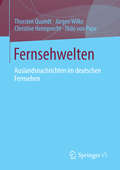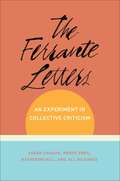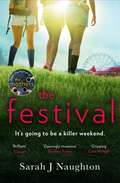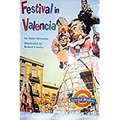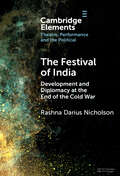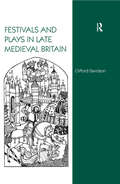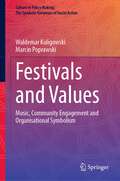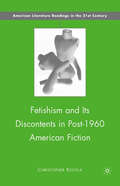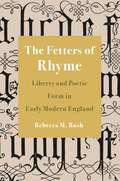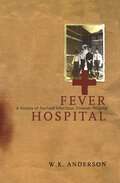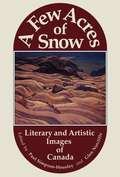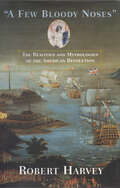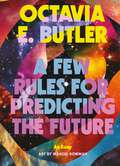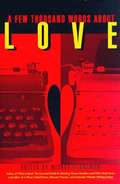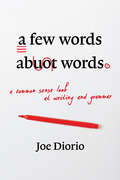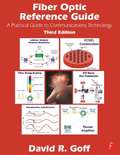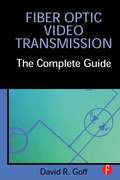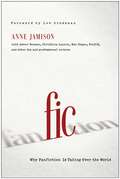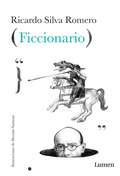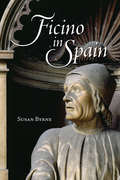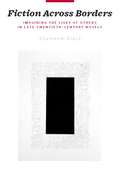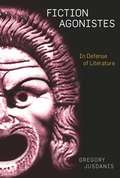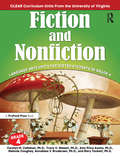- Table View
- List View
Fernsehwelten
by Thorsten Quandt Jürgen Wilke Christine Heimprecht Thilo PapeDer Band vermittelt ein eindrückliches Bild vom Stand der Auslandsberichterstattung im deutschen Fernsehen. Auf der Basis inhaltsanalytischer Untersuchungen, einer Repräsentativbefragung unter deutschen Fernsehzuschauern sowie Leitfadeninterviews mit Journalisten aus den produzierenden Redaktionen werden die Erkenntnisse eines umfassenden Projekts zur Erforschung der Auslandsnachrichten im deutschen Fernsehen diskutiert.
The Ferrante Letters: An Experiment in Collective Criticism (Literature Now)
by Sarah Chihaya Merve Emre Katherine Hill Jill RichardsLike few other works of contemporary literature, Elena Ferrante’s Neapolitan novels found an audience of passionate and engaged readers around the world. Inspired by Ferrante’s intense depiction of female friendship and women’s intellectual lives, four critics embarked upon a project that was both work and play: to create a series of epistolary readings of the Neapolitan Quartet that also develops new ways of reading and thinking together.In a series of intertwined, original, and daring readings of Ferrante’s work and her fictional world, Sarah Chihaya, Merve Emre, Katherine Hill, and Jill Richards strike a tone at once critical and personal, achieving a way of talking about literature that falls between the seminar and the book club. Their letters make visible the slow, fractured, and creative accretion of ideas that underwrites all literary criticism and also illuminate the authors’ lives outside the academy. The Ferrante Letters offers an improvisational, collaborative, and cumulative model for reading and writing with others, proposing a new method the authors call collective criticism. A book for fans of Ferrante and for literary scholars seeking fresh modes of intellectual exchange, The Ferrante Letters offers incisive criticism, insouciant riffs, and the pleasure of giving oneself over to an extended conversation about fiction with friends.
The Festival
by Sarah J. NaughtonFROM THE NUMBER ONE BESTSELLING AUTHOR'Dazzlingly inventive'Sunday Times'Gripping and powerful'Cara Hunter**********FOUR WOMEN.Orly, Lenny, Mel and Thea have been best friends since school. But now it is 20 years later and inevitably they have drifted apart.ONE WEEKEND.It is Lenny's 40th birthday, plus Orly and Mel need cheering up, so Thea suggests a weekend away at a festival in their hometown. It's a chance for them all to reconnect. NOT ALL OF THEM WILL SURVIVE.But their holiday soon takes a sinister turn, and not all of the friends will leave the festival alive...
The Festival of India: Development and Diplomacy at the End of the Cold War (Elements in Theatre, Performance and the Political)
by Rashna Darius NicholsonAn in-depth study of the Festival of India (1985–1986) in the United States, one of the biggest events ever mounted to promote goodwill between two countries. Comprising more than seven hundred programs of music, dance, drama, film shows, art exhibitions, and workshops sponsored by over two hundred cultural institutions across over a hundred cities, the festival constituted a prismatic event that refracted the complex forces at play on the global stage during the 1980s. The Element delineates how this multi-sited spectacle of unprecedented size and near unfathomable political, economic, and cultural influence impacted theatre and performance studies. Simultaneously, it traces how two complex historical shifts were communicated to the global public at the end of the Cold War: India's desire to transition from planned Nehruvian socialism to laissez faire capitalism and the efflorescence of the model of 'cultural development' that centred the arts in development.
Festivals and Plays in Late Medieval Britain
by Clifford DavidsonBased in records and iconography, this book surveys medieval festival playing in Britain more comprehensively than any other work to date. The study presents an inclusive view of the drama in the British Isles, from Kilkenny to Great Yarmouth, from Scotland to Cornwall. It offers detailed readings of individual plays-including the York Creed Play, Pentecost and Corpus Christi plays and the little studied Bodley plays, among others - as well as a summary of what is known of their production. Clifford Davidson here extends the usual chronological range to include work typically categorized as early modern, enabling a juxtaposition of earlier plays with later plays to yield a better understanding of both. Complementing documentary evidence with iconographic detail and citation of music, he pinpoints a number of common misconceptions about medieval drama. By organizing the study around the rituals of the liturgical seasons, he clarifies the relationship between liturgical feast and dramatic celebration.
Festivals and Values: Music, Community Engagement and Organisational Symbolism (Culture in Policy Making: The Symbolic Universes of Social Action)
by Waldemar Kuligowski Marcin PoprawskiThis is an original book, covering all the past areas of research anyone would need to know about festivals and ‘event-based culture’. It is based on academic research but written in a way relevant for cultural professionals – uniquely explaining the cultural power of festivals, and with original empirical research, the realities of organisation and management, and social and economic value. Dr Jonathan Vickery, Reader in Cultural Policy Studies and Director: Centre for Cultural and Media Policy Studies, Univeristy of Warwick.This book discusses music festivals in the context of the specific values they convey. Today, music festivals are a permanent feature of national, regional and local cultural policies, a valuable asset in the tourism industry and a significant source of income for an industry that has been adversely affected by the steady decline in physical sales of music. For the audience, on the other hand, it is an opportunity to escape from everyday life, multi-sensory contact with art, an activity that stands for “full-body participation”– a cultural phenomenon that drags people out of their homes like no other. There is one common denominator linking the above-mentioned features of contemporary music festivals – namely the world of values. This is evident from the non-accidental locations, festivals spaces’ design, planning and the line-ups created consciously, with great care. The organisers’ “missions”, logos, and other symbolic organisational artefacts communicate specific values. These values are explicitly mentioned by artists and audiences: they can be easily identified in online forums and media reports; participant behaviour, festival “rituals” and additional festival programs are shaped on the basis of values, and cooperation is built between the festival and the local community. As the reader will quickly realize, numbers and statistics sit alongside descriptions and quotations in this book, and the organisers’ statements are accompanied by the opinions of academics, but above all the festival audience is given a voice – both through quotations and their drawings. This voice is by no means uniform, as it turned out that research into values was often transformed into a pretext for spinning tales about one’s life situation, one’s political preferences, and one’s understanding of freedom and responsibility. Memories were mixed with declarations, joy with regret, curses with dreams, prose with poetry. Thomas Pettitt was not wrong in noting that “Social history has learnt to appreciate festival as a valuable window on society and its structures”. The authors have tried to open all the windows available. Students and researchers in the fields of cultural anthropology, social psychology, folklore studies, comparative religion, sociology of culture, cultural policy, cultural history, and cultural management will find this book highly interesting.
Fetishism and Its Discontents in Post-1960 American Fiction
by Christopher KocelaThis study explores the concept of fetishism as a strategy for expressing social and political discontent in American literature, and for negotiating traumatic experiences particular to the second half of the twentieth century.
The Fetters of Rhyme: Liberty and Poetic Form in Early Modern England
by Rebecca M. RushHow rhyme became entangled with debates about the nature of liberty in sixteenth- and seventeenth-century English poetryIn his 1668 preface to Paradise Lost, John Milton rejected the use of rhyme, portraying himself as a revolutionary freeing English verse from “the troublesome and modern bondage of Riming.” Despite his claim to be a pioneer, Milton was not initiating a new line of thought—English poets had been debating about rhyme and its connections to liberty, freedom, and constraint since Queen Elizabeth’s reign. The Fetters of Rhyme traces this dynamic history of rhyme from the 1590s through the 1670s. Rebecca Rush uncovers the surprising associations early modern readers attached to rhyming forms like couplets and sonnets, and she shows how reading poetic form from a historical perspective yields fresh insights into verse’s complexities.Rush explores how early modern poets imagined rhyme as a band or fetter, comparing it to the bonds linking individuals to political, social, and religious communities. She considers how Edmund Spenser’s sonnet rhymes stood as emblems of voluntary confinement, how John Donne’s revival of the Chaucerian couplet signaled sexual and political radicalism, and how Ben Jonson’s verse charted a middle way between licentious Elizabethan couplet poets and slavish sonneteers. Rush then looks at why the royalist poets embraced the prerational charms of rhyme, and how Milton spent his career reckoning with rhyme’s allures.Examining a poetic feature that sits between sound and sense, liberty and measure, The Fetters of Rhyme elucidates early modern efforts to negotiate these forces in verse making and reading.
Fever Hospital: A History of Fairfield Infectious Diseases HospitaL
by W K AndersonInfectious diseases have threatened life and social order throughout human history, inducing deep and pervasive fear. The story of Fairfield Hospital is central to the story of infectious diseases in Victoria, and is thus a significant chapter in Australia's history. Fairfield Infectious Diseases Hospital began life in 1904 as a fever hospital. It treated patients for typhoid, diphtheria, cholera and smallpox, and grappled with epidemics of polio and scarlet fever. It later became one of the world's foremost centres for the research and treatment of infectious diseases, especially HIV/AIDS. And then it was closed, in 1996, amid controversy, protest and distress. Fever Hospital is an invaluable record of the work and achievements of Fairfield. W. K. Anderson sets these achievements in the context of Australian developments in medicine and health. He describes important initiatives in research, medical treatment and patient care. He traces a century of change in organisational structure and personnel. The combined expertise of the Fairfield Hospital team is now scattered. But Anderson, in gathering together the fruits of their knowledge, experience and skill, has ensured that the story of a remarkable and much-loved hospital is not lost to us. Fever Hospital is a valuable social and institutional history. But above all it is a faithful, tangible and generously illustrated record of a great hospital, written for the people who worked at Fairfield and for those who found healing and comfort there.
A Few Acres of Snow: Literary and Artistic Images of Canada
by Paul Simpson-Housley Glen NorcliffeIn 1759, Voltaire in Candide referred to Canada as "quelques arpents de neige." For several centuries, the image prevailed and was the one most frequently used by poets, writers, and illustrators. Canada was perceived and portrayed as a cold, hard, and unforgiving land. this was not a land for the fainthearted. Canada has yieled its wealth only reluctantly, while periodically threatening life itself with its displays of fury. Discovering its beauty and hidden resources requires patience and perseverance. A Few Acres of Snow is a colletion of twenty-two essays that explore, from the geographer’s perspective, how poets, artists, and writers have addressed the physical essence of Canada, both landscape and cityscape. "Sense of place" is clearly critical in the works examined in this volume. Included among the book’s many subjects are Hugh MacLennan, Gabrielle Roy, Lucius O’Brien, the art of the Inuit, Lawren Harris, Malcolm Lowry, C.W. Jefferys, L.M. Montgomery, Elizabeth Bishop, Marmaduke Matthews, Antonine Mailet, and the poetry of Japanese Canadians.
"A Few Bloody Noses": The Realities and Mythologies of the American Revolution
by Robert HarveyThe noted British historian and author of Liberators offers a colorful, enlightening and myth-busting history of the American Revolution.According to King George III, Britain merely wanted to give America “a few bloody noses” and return to mutual cooperation. Yet the ensuing uprising led to the creation of the United States, the most powerful country in the modern world. In “A Few Bloody Noses”, Robert Harvey challenges conventional views of the American Revolution in almost every aspect—why it happened; who was winning and when; the characters of the principal protagonists; and the role of Native Americans and enslaved people. Harvey takes a penetrating look at a war that was both vicious and confused, bloody and protracted, and marred on both sides by incompetence and bad faith. He underscores the effect of the Revolution on the settlers in America, and those at home in Britain—the country that the settlers had left behind, and to which many returned. The result is an extraordinarily fascinating and thoroughly readable account.
A Few Rules for Predicting the Future
by Octavia E. Butler'There's no single answer that will solve all our future problems.There's no magic bullet.Instead there are thousands of answers - at least.You can be one of them if you choose to be'***Honest and wise advice from legendary writer and Afrofuturist pioneer, Octavia E. Butler - for anyone who wants to shape our future into something good.A little book to give or to keep, with stunning new artwork by Manzel Bowman.Based on an essay written in 2000. As timely and prescient today as it was then.
A Few Thousand Words about Love
by Mickey PearlmanMickey Pearlman invited established writers and rising stars to think about that eternally evocative subject. The answer that emerged from these gifted writers is a collection of original memoirs about: a Broadway songwriting grandmother, the adoption of a biracial daughter, the love of a gay man for his aging grandmother, a Chinese father's love letters to the writer's mother, a traumatic but transformative childbirth experience, a love affair with one's wife in Paris, and the familiar sibling rivalry between a toddler and her newborn sister. Like fresh rain falling on time-worn Parisian streets, the writers--Peter Cameron, Ron Carlson, Angela Davis-Gardner, Tim Gautreaux, Myra Goldberg, Brian Hall, Linda Hogan, Caroline Leavitt, Margot Livesey, Elizabeth McCracken, Dennis McFarland, Joyce Carol Oates, Larry O'Connor, Mickey Pearlman, Carolyn See, Katharine Weber, and Shawn Wong--play a contemporary riff on an age-old song.
A Few Words About Words
by Joseph J. DiorioHONORED AS A NOTABLE 100 BOOK IN THE 2021 SHELF UNBOUND BEST INDIE BOOK COMPETITIONFINALIST FOR THE 2021 FOREWORD INDIES AWARDSPenned by a writer who had to teach himself the rules of English grammar, A Few Words About Words offers an easy and accessible approach to understanding and using the English language.In a world dominated by countless print and social media outlets, written communication is king. Writing "your" when you mean "you're" and "there" when you mean "they're" can make the difference between getting or not getting new business. A missing comma can result in a PR catastrophe, and a well-written line can be remembered for generations. And yet, many native speakers struggle with the English language.Spawned from the widely-circulated and beloved newsletter of the same name, Joe Diorio's A Few Words About Words blends quick-witted anecdotes from more than 30 years of newsletter entries that highlight the common, uncommon, and surprising grammar mistakes most English speakers make. The result is a digestible, all-encompassing look at English grammar.Humorous, enlightening, and completely comprehensible, A Few Words About Words will be the go-to grammar guide you pick up and can't put down.
Fiber Optic Reference Guide: A Practical Guide To The Technology
by David GoffThe Fiber Optic Reference Guide offers readers a solid understanding of the principles of fiber optic technology, especially as it relates to telecommunications, from its early days to developing future trends. Using a minimum of jargon and a wealth of illustrations, this book provides the underlying principles of fiber optics as well as essential practical applications. The third edition is updated to include expanded sections on light emitters, semiconductor optical amplifiers, Bragg gratings, and more systems design considerations. Fiber optics plays a key role in communications, as well as in broadcast and cable systems. Engineers working with fiber optics as well as newcomers to the industry will find the third edition of this reference guide invaluable. It will help the reader develop a solid understanding of the underlying principles of this rapidly changing technology as well as its essential practical applications. The text is thoroughly indexed and illustrated.
Fiber Optic Video Transmission: The Complete Guide
by David GoffFiber Optic Video Transmission: The Complete Guide is the only comprehensive reference to the techniques and hardware required to transmit video signals over optical fiber. As the broadcast industry moves to HDTV and enhanced television standards become the norm, fiber will become the medium of choice for video transmission, and this book is the essential guide to transmitting video over fiber optic cables. From the most basic video signal to complex multi-channel high definition video, this book details the methods of encoding video signals (including AM, FM, and digital encoding), the advantages and disadvantages of all encoding methods, and the expected performance of each method. A discussion of the the fiber optic components - such as lasers, LEDs, detectors, connectors, and other components - that are best for video transmission applications is also included. A glossary of terms, appendices of standards and publications, and a complete index round out this comprehensive guide.
Fic: Why Fanfiction Is Taking Over the World
by Anne JamisonWhat is fanfiction, and what is it not? Why does fanfiction matter? And what makes it so important to the future of literature? Fic is a groundbreaking exploration of the history and culture of fan writing and what it means for the way we think about reading, writing, and authorship. It's a story about literature, community, and technology—about what stories are being told, who's telling them, how, and why. With provocative discussions from both professional and fan writers, on subjects from Star Trek to The X-Files and Buffy the Vampire Slayer to Harry Potter, Twilight, and beyond, Fic sheds light on the widely misunderstood world(s) of fanfiction—not only how fanfiction is transforming the literary landscape, but how it already has. Fic features a foreword by Lev Grossman (author of The Magicians) and interviews with Jonathan Lethem, Doug Wright, Eurydice (Vivean Dean), and Katie Forsythe/wordstrings. Cyndy Aleo (algonquinrt; d0tpark3r) V. Arrow (aimmyarrowshigh) Tish Beaty (his_tweet) Brad Bell Amber Benson Peter Berg (Homfrog) Kristina Busse Rachel Caine Francesca Coppa Randi Flanagan (BellaFlan) Jolie Fontenot Wendy C. Fries (Atlin Merrick) Ron Hogan Bethan Jones Christina Lauren (Christina Hobbs/tby789 and Lauren Billings/LolaShoes) Jacqueline Lichtenberg Rukmini Pande and Samira Nadkarni Chris Rankin Tiffany Reisz Andrew Shaffer Andy Sawyer Heidi Tandy (Heidi8) Darren Wershler Jules Wilkinson (missyjack) Jen Zern (NautiBitz)
Ficcionario
by Ricardo Silva RomeroTreinta y cinco definiciones sobre la ficción y el drama de uno de los autores colombianos más importantes de la actualidad. "Puede ser que las cosas pasen porque sí, pero yo me he jugado la vida por el drama. He creído, porque en algo hay que creer, que todo sucede por algo y para algo. Y que cada historia del mundo puede ser contada en tres actos". Ricardo Silva Romero Lo primero que el lector debe saber sobre este Ficcionario es que no es, precisamente, un libro de ensayos sobre literatura. Sí es, en cambio, una colección de respuestas a treinta y cinco sospechas que Ricardo Silva Romero ha venido despejando a lo largo de su vida como escritor, sobre las formas en las que el drama -o la ilusión de que todo tiene sentido- está presente en la vida y en las distintas manifestaciones del arte. A modo de bestiario de la ficción, y con ilustraciones de Hernán Sansone para abrir cada capítulo, aquí el autor realiza un inventario de sus pasiones -el cine de Alfred Hitchcock, de Martin Scorsese, de Woody Allen, de Mike Nichols; la literatura de Alejandro Dumas, de Paul Auster, de los hermanos Grimm; la poesía de César Vallejo; la música de Paul Simon, entre muchas otras-, que ejemplifican de manera brillante una amplia gama de temas relacionados con las decisiones que hay detrás de cada historia y de cada personaje. Escrito con un profundo respeto por el oficio, Ficcionario es un libro esencial para lectores, espectadores, directores, escritores o cualquier persona interesada en descifrar el arte de contar historias.
Ficino in Spain
by Susan ByrneAs the first translator of Plato's complete works into Latin, the Florentine writer Marsilio Ficino (1433-99) and his blend of Neoplatonic and Hermetic philosophy were fundamental to the intellectual atmosphere of the Renaissance. In Spain, his works were regularly read, quoted, and referenced, at least until the nineteenth century, when literary critics and philosophers wrote him out of the history of early modern Spain.In Ficino in Spain, Susan Byrne uses textual and bibliographic evidence to show the pervasive impact of Ficino's writings and translations on the Spanish Renaissance. Cataloguing everything from specific mentions of his name in major texts to glossed volumes of his works in Spanish libraries, Byrne shows that Spanish writers such as Miguel de Cervantes, Lope de Vega, Bartolomé de las Casas, and Garcilaso de la Vega all responded to Ficino and adapted his imagery for their own works. An important contribution to the study of Spanish literature and culture from the fifteenth to the seventeenth centuries, Ficino in Spain recovers the role that Hermetic and Neoplatonic thought played in the world of Spanish literature.
Fiction Across Borders: Imagining the Lives of Others in Late-Twentieth-Century Novels
by Shameem BlackTheorists of Orientalism and postcolonialism argue that novelists betray political and cultural anxieties when characterizing "the Other." Shameem Black takes a different stance. Turning a fresh eye toward several key contemporary novelists, she reveals how "border-crossing" fiction represents socially diverse groups without resorting to stereotype, idealization, or other forms of imaginative constraint. Focusing on the work of J. M. Coetzee, Amitav Ghosh, Jeffrey Eugenides, Ruth Ozeki, Charles Johnson, Gish Jen, and Rupa Bajwa, Black introduces an interpretative lens that captures the ways in which these authors envision an ethics of representing social difference. They not only offer sympathetic portrayals of the lives of others but also detail the processes of imagining social difference. Whether depicting the multilingual worlds of South and Southeast Asia, the exportation of American culture abroad, or the racial tension of postapartheid South Africa, these transcultural representations explore social and political hierarchies in constructive ways. Boldly confronting the orthodoxies of recent literary criticism, Fiction Across Borders builds upon such seminal works as Edward Said's Orientalism and offers a provocative new study of the late twentieth-century novel.
Fiction Across Borders: Imagining the Lives of Others in Late-Twentieth-Century Novels
by Shameem BlackTheorists of Orientalism and postcolonialism argue that novelists betray political and cultural anxieties when characterizing "the Other." Shameem Black takes a different stance. Turning a fresh eye toward several key contemporary novelists, she reveals how "border-crossing" fiction represents socially diverse groups without resorting to stereotype, idealization, or other forms of imaginative constraint. Focusing on the work of J. M. Coetzee, Amitav Ghosh, Jeffrey Eugenides, Ruth Ozeki, Charles Johnson, Gish Jen, and Rupa Bajwa, Black introduces an interpretative lens that captures the ways in which these authors envision an ethics of representing social difference. They not only offer sympathetic portrayals of the lives of others but also detail the processes of imagining social difference. Whether depicting the multilingual worlds of South and Southeast Asia, the exportation of American culture abroad, or the racial tension of postapartheid South Africa, these transcultural representations explore social and political hierarchies in constructive ways. Boldly confronting the orthodoxies of recent literary criticism, Fiction Across Borders builds upon such seminal works as Edward Said's Orientalism and offers a provocative new study of the late twentieth-century novel.
Fiction Agonistes: In Defense of Literature
by Gregory JusdanisJusdanis, who is not further identified, defends literature as a form of art, and art as a purveyor of beauty, and beauty as one of the necessary conditions for being human, one that has been neglected at best but too often heaped with facile praise or denigration in the jaded spheres of academe. He considers overture and themes, art's apology, two autonomies, art as parabasis, the line between living and pretending, and the future of a fiction. Annotation ©2010 Book News, Inc. , Portland, OR (booknews. com)
Fiction and Nonfiction: Language Arts Units for Gifted Students in Grade 4
by Carolyn M. Callahan Tracy C. MissettThe CLEAR curriculum, developed by University of Virginia's National Research Center on the Gifted and Talented, is an evidence-based teaching model that emphasizes Challenge Leading to Engagement, Achievement, and Results. In Fiction and Nonfiction: Language Arts Units for Gifted Students in Grade 4, students will read and analyze short stories and write their own short story in the fiction unit. In the nonfiction unit, students will study nonfiction (and creative nonfiction) texts to examine how writers use many of the same devices to tell nonfiction stories. Students will read a variety of texts and will write their own memoirs. These units focus on critical literacy skills, including reading diverse content, understanding texts as reflections of culture, and finding bias in fiction and nonfiction.Grade 4
